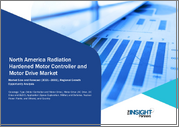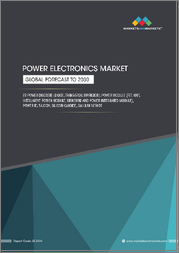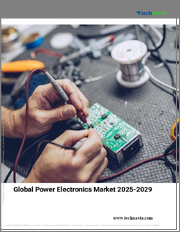
|
시장보고서
상품코드
1743766
세계의 파워 일렉트로닉스 시험 시장 - 산업 규모, 점유율, 동향, 기회, 예측 : 디바이스 유형별, 용도별, 제공별, 지역별, 경쟁별(2020-2030년)Power Electronic Testing Market - Global Industry Size, Share, Trends, Opportunity, and Forecast, Segmented By Device Type, By Application, By Offering, By Region, By Competition, 2020-2030F |
||||||
세계의 파워 일렉트로닉스 시험 시장 규모는 2024년에 33억 달러로 평가되었고, 예측 기간 중의 CAGR은 6.7%를 나타내, 2030년에는 49억 달러에 달할 것으로 전망되고 있습니다.
특히, 효율적이고 신뢰성 있는 에너지 변환이 중요한 전기자동차(EV) 분야에서는 고성능 파워 일렉트로닉스 부품에 대한 수요가 높아지고 있는 것이 시장 확대에 박차를 가하고 있습니다. 또한 태양광과 풍력과 같은 신재생에너지원이 증가함에 따라 원활한 그리드 통합과 전력변환을 보장하기 위한 견고한 테스트가 필요합니다. 또한 실리콘 카바이드(SiC)와 갈륨 질화물(GaN)과 같은 광대역 갭 반도체 기술의 보급은 새로운 복잡한 테스트를 도입하고 고급 검증 시스템의 필요성을 촉구하고 있습니다. 산업 자동화 증가와 5G 인프라의 전개는 파워 일렉트로닉스 시험의 중요성을 더욱 향상시키고 있습니다. 전 세계적으로 규제 규정 준수 및 안전 기준은 계속해서 엄격한 시험 프로토콜을 강제하고 있으며, 전체적으로 역동적이고 혁신 중심 시장 상황을 창출하고 있습니다.
| 시장 개요 | |
|---|---|
| 예측 기간 | 2026-2030년 |
| 시장 규모(2024년) | 33억 달러 |
| 시장 규모(2030년) | 49억 달러 |
| CAGR(2025-2030년) | 6.7% |
| 급성장 부문 | 파워 이산 장치 |
| 최대 시장 | 북미 |
시장 성장 촉진요인
전기자동차(EV) 보급의 급증이 파워 일렉트로닉스 시험 수요를 견인
주요 시장 과제
고급 전력 전자 부품 테스트의 복잡성과 높은 비용
주요 시장 동향
자동화 및 AI 주도 테스트 솔루션 채택 증가
목차
제1장 개요
제2장 조사 방법
제3장 주요 요약
제4장 고객의 목소리
제5장 세계의 파워 일렉트로닉스 시험 시장 전망
- 시장 규모 및 예측
- 금액별
- 시장 점유율 및 예측
- 디바이스 유형별(파워 개별 장치, 파워 모듈, 기타)
- 용도별(소비자용 전자기기, 전력, 산업, 자동차, 항공우주 및 방위, 기타)
- 제공 내용(시험 장치, 시험 서비스)
- 지역별(북미, 유럽, 남미, 중동 및 아프리카, 아시아태평양)
- 기업별(2024년)
- 시장 맵
제6장 북미의 파워 일렉트로닉스 시험 시장 전망
- 시장 규모 및 예측
- 시장 점유율 및 예측
- 북미 : 국가별 분석
- 미국
- 캐나다
- 멕시코
제7장 유럽의 파워 일렉트로닉스 시험 시장 전망
- 시장 규모 및 예측
- 시장 점유율 및 예측
- 유럽 : 국가별 분석
- 독일
- 프랑스
- 영국
- 이탈리아
- 스페인
제8장 아시아태평양의 파워 일렉트로닉스 시험 시장 전망
- 시장 규모 및 예측
- 시장 점유율 및 예측
- 아시아태평양 : 국가별 분석
- 중국
- 인도
- 일본
- 한국
- 호주
제9장 중동 및 아프리카의 파워 일렉트로닉스 시험 시장 전망
- 시장 규모 및 예측
- 시장 점유율 및 예측
- 중동 및 아프리카 : 국가별 분석
- 사우디아라비아
- 아랍에미리트(UAE)
- 남아프리카
제10장 남미의 파워 일렉트로닉스 시험 시장 전망
- 시장 규모 및 예측
- 시장 점유율 및 예측
- 남미 : 국가별 분석
- 브라질
- 콜롬비아
- 아르헨티나
제11장 시장 역학
- 성장 촉진요인
- 과제
제12장 시장 동향과 발전
- 합병과 인수
- 제품 출시
- 최근 동향
제13장 기업 프로파일
- Keysight Technologies, Inc.
- Tektronix, Inc.
- Rohde & Schwarz GmbH & Co KG
- National Instruments Corporation
- Microtest Group
- Advantest Corporation
- Teradyne, Inc.
- Infineon Technologies AG
제14장 전략적 제안
제15장 기업 소개와 면책사항
KTH 25.06.18The Global Power Electronic Testing Market was valued at USD 3.3 billion in 2024 and is projected to reach USD 4.9 billion by 2030, growing at a CAGR of 6.7% during the forecast period. Market expansion is fueled by rising demand for high-performance power electronic components, particularly in the electric vehicle (EV) sector, where efficient and reliable energy conversion is critical. The growth of renewable energy sources such as solar and wind also necessitates robust testing to ensure seamless grid integration and power conversion. Additionally, the proliferation of wide-bandgap semiconductor technologies like Silicon Carbide (SiC) and Gallium Nitride (GaN) has introduced new testing complexities, driving the need for advanced validation systems. Increasing industrial automation and the rollout of 5G infrastructure further elevate the importance of power electronics testing. Globally, regulatory compliance and safety standards continue to enforce stringent testing protocols, collectively creating a dynamic and innovation-driven market landscape.
| Market Overview | |
|---|---|
| Forecast Period | 2026-2030 |
| Market Size 2024 | USD 3.3 Billion |
| Market Size 2030 | USD 4.9 Billion |
| CAGR 2025-2030 | 6.7% |
| Fastest Growing Segment | Power Discrete Devices |
| Largest Market | North America |
Key Market Drivers
Surge in Electric Vehicle (EV) Adoption Driving Demand for Power Electronic Testing
The rapid rise in global electric vehicle (EV) adoption is a major catalyst for the power electronic testing market. EVs rely heavily on complex power electronic systems such as inverters, converters, and battery management units that must meet rigorous performance and safety standards. As governments and industries accelerate EV production to reduce carbon emissions, the need for comprehensive and reliable testing grows substantially. In March 2025, Germany's dSPACE introduced the XSG Power Electronics Systems software, supporting simulations at high switching frequencies up to 500 kHz, a development that underscores the rising sophistication in power electronics. These systems must endure fluctuating loads and extreme conditions, necessitating robust testing to validate efficiency, reliability, and compliance before deployment.
Key Market Challenges
Complexity and High Cost of Testing Advanced Power Electronic Components
A significant challenge for the market is the complexity and high cost associated with testing modern power electronics, especially those utilizing wide-bandgap materials like SiC and GaN. These components offer enhanced performance but demand specialized testing environments capable of handling higher frequencies, voltages, and thermal variations. Building and operating such advanced testing infrastructure involves substantial investment in equipment, automation, and skilled labor. For smaller firms and those in developing regions, this creates financial and technical barriers to entry. Without sufficient capital or access to cutting-edge tools, these entities may struggle to adopt high-end testing solutions, thereby limiting their market competitiveness.
Key Market Trends
Increasing Adoption of Automation and AI-Driven Testing Solutions
Automation and AI integration are reshaping the power electronic testing market, offering faster, more accurate, and more efficient testing workflows. As components grow more advanced, traditional testing methods fall short in terms of precision and scalability. Automated test equipment (ATE) and AI-powered systems are now being employed to streamline testing cycles, reduce human error, and enhance throughput. These technologies allow real-time data collection, pattern recognition, and adaptive testing, helping manufacturers optimize product quality and reliability. Additionally, predictive analytics and condition-based maintenance powered by machine learning are gaining traction, minimizing unplanned failures and extending equipment lifespan, particularly in sectors like EVs and renewable energy.
Key Market Players
- Keysight Technologies, Inc.
- Tektronix, Inc.
- Rohde & Schwarz GmbH & Co KG
- National Instruments Corporation
- Microtest Group
- Advantest Corporation
- Teradyne, Inc.
- Infineon Technologies AG
Report Scope:
In this report, the Global Power Electronic Testing Market has been segmented into the following categories, in addition to the industry trends which have also been detailed below:
Power Electronic Testing Market, By Device Type:
- Power Discrete Devices
- Power Modules
- Others
Power Electronic Testing Market, By Application:
- Consumer Electronics
- Power
- Industrial
- Automotive
- Aerospace & Defense
- Others
Power Electronic Testing Market, By Offering:
- Testing Equipment
- Testing Service
Power Electronic Testing Market, By Region:
- North America
- United States
- Canada
- Mexico
- Europe
- Germany
- France
- United Kingdom
- Italy
- Spain
- Asia Pacific
- China
- India
- Japan
- South Korea
- Australia
- South America
- Brazil
- Colombia
- Argentina
- Middle East & Africa
- Saudi Arabia
- UAE
- South Africa
Competitive Landscape
Company Profiles: Detailed analysis of the major companies present in the Global Power Electronic Testing Market.
Available Customizations:
Global Power Electronic Testing Market report with the given market data, TechSci Research offers customizations according to a company's specific needs. The following customization options are available for the report:
Company Information
- Detailed analysis and profiling of additional market players (up to five).
Table of Contents
1. Product Overview
- 1.1. Market Definition
- 1.2. Scope of the Market
- 1.2.1. Markets Covered
- 1.2.2. Years Considered for Study
- 1.2.3. Key Market Segmentations
2. Research Methodology
- 2.1. Objective of the Study
- 2.2. Baseline Methodology
- 2.3. Key Industry Partners
- 2.4. Major Association and Secondary Sources
- 2.5. Forecasting Methodology
- 2.6. Data Triangulation & Validation
- 2.7. Assumptions and Limitations
3. Executive Summary
- 3.1. Overview of the Market
- 3.2. Overview of Key Market Segmentations
- 3.3. Overview of Key Market Players
- 3.4. Overview of Key Regions/Countries
- 3.5. Overview of Market Drivers, Challenges, and Trends
4. Voice of Customer
5. Global Power Electronic Testing Market Outlook
- 5.1. Market Size & Forecast
- 5.1.1. By Value
- 5.2. Market Share & Forecast
- 5.2.1. By Device Type (Power Discrete Devices, Power Modules, Others)
- 5.2.2. By Application (Consumer Electronics, Power, Industrial, Automotive, Aerospace & Defense, Others)
- 5.2.3. By Offering (Testing Equipment, Testing Service)
- 5.2.4. By Region (North America, Europe, South America, Middle East & Africa, Asia Pacific)
- 5.3. By Company (2024)
- 5.4. Market Map
6. North America Power Electronic Testing Market Outlook
- 6.1. Market Size & Forecast
- 6.1.1. By Value
- 6.2. Market Share & Forecast
- 6.2.1. By Device Type
- 6.2.2. By Application
- 6.2.3. By Offering
- 6.2.4. By Country
- 6.3. North America: Country Analysis
- 6.3.1. United States Power Electronic Testing Market Outlook
- 6.3.1.1. Market Size & Forecast
- 6.3.1.1.1. By Value
- 6.3.1.2. Market Share & Forecast
- 6.3.1.2.1. By Device Type
- 6.3.1.2.2. By Application
- 6.3.1.2.3. By Offering
- 6.3.1.1. Market Size & Forecast
- 6.3.2. Canada Power Electronic Testing Market Outlook
- 6.3.2.1. Market Size & Forecast
- 6.3.2.1.1. By Value
- 6.3.2.2. Market Share & Forecast
- 6.3.2.2.1. By Device Type
- 6.3.2.2.2. By Application
- 6.3.2.2.3. By Offering
- 6.3.2.1. Market Size & Forecast
- 6.3.3. Mexico Power Electronic Testing Market Outlook
- 6.3.3.1. Market Size & Forecast
- 6.3.3.1.1. By Value
- 6.3.3.2. Market Share & Forecast
- 6.3.3.2.1. By Device Type
- 6.3.3.2.2. By Application
- 6.3.3.2.3. By Offering
- 6.3.3.1. Market Size & Forecast
- 6.3.1. United States Power Electronic Testing Market Outlook
7. Europe Power Electronic Testing Market Outlook
- 7.1. Market Size & Forecast
- 7.1.1. By Value
- 7.2. Market Share & Forecast
- 7.2.1. By Device Type
- 7.2.2. By Application
- 7.2.3. By Offering
- 7.2.4. By Country
- 7.3. Europe: Country Analysis
- 7.3.1. Germany Power Electronic Testing Market Outlook
- 7.3.1.1. Market Size & Forecast
- 7.3.1.1.1. By Value
- 7.3.1.2. Market Share & Forecast
- 7.3.1.2.1. By Device Type
- 7.3.1.2.2. By Application
- 7.3.1.2.3. By Offering
- 7.3.1.1. Market Size & Forecast
- 7.3.2. France Power Electronic Testing Market Outlook
- 7.3.2.1. Market Size & Forecast
- 7.3.2.1.1. By Value
- 7.3.2.2. Market Share & Forecast
- 7.3.2.2.1. By Device Type
- 7.3.2.2.2. By Application
- 7.3.2.2.3. By Offering
- 7.3.2.1. Market Size & Forecast
- 7.3.3. United Kingdom Power Electronic Testing Market Outlook
- 7.3.3.1. Market Size & Forecast
- 7.3.3.1.1. By Value
- 7.3.3.2. Market Share & Forecast
- 7.3.3.2.1. By Device Type
- 7.3.3.2.2. By Application
- 7.3.3.2.3. By Offering
- 7.3.3.1. Market Size & Forecast
- 7.3.4. Italy Power Electronic Testing Market Outlook
- 7.3.4.1. Market Size & Forecast
- 7.3.4.1.1. By Value
- 7.3.4.2. Market Share & Forecast
- 7.3.4.2.1. By Device Type
- 7.3.4.2.2. By Application
- 7.3.4.2.3. By Offering
- 7.3.4.1. Market Size & Forecast
- 7.3.5. Spain Power Electronic Testing Market Outlook
- 7.3.5.1. Market Size & Forecast
- 7.3.5.1.1. By Value
- 7.3.5.2. Market Share & Forecast
- 7.3.5.2.1. By Device Type
- 7.3.5.2.2. By Application
- 7.3.5.2.3. By Offering
- 7.3.5.1. Market Size & Forecast
- 7.3.1. Germany Power Electronic Testing Market Outlook
8. Asia Pacific Power Electronic Testing Market Outlook
- 8.1. Market Size & Forecast
- 8.1.1. By Value
- 8.2. Market Share & Forecast
- 8.2.1. By Device Type
- 8.2.2. By Application
- 8.2.3. By Offering
- 8.2.4. By Country
- 8.3. Asia Pacific: Country Analysis
- 8.3.1. China Power Electronic Testing Market Outlook
- 8.3.1.1. Market Size & Forecast
- 8.3.1.1.1. By Value
- 8.3.1.2. Market Share & Forecast
- 8.3.1.2.1. By Device Type
- 8.3.1.2.2. By Application
- 8.3.1.2.3. By Offering
- 8.3.1.1. Market Size & Forecast
- 8.3.2. India Power Electronic Testing Market Outlook
- 8.3.2.1. Market Size & Forecast
- 8.3.2.1.1. By Value
- 8.3.2.2. Market Share & Forecast
- 8.3.2.2.1. By Device Type
- 8.3.2.2.2. By Application
- 8.3.2.2.3. By Offering
- 8.3.2.1. Market Size & Forecast
- 8.3.3. Japan Power Electronic Testing Market Outlook
- 8.3.3.1. Market Size & Forecast
- 8.3.3.1.1. By Value
- 8.3.3.2. Market Share & Forecast
- 8.3.3.2.1. By Device Type
- 8.3.3.2.2. By Application
- 8.3.3.2.3. By Offering
- 8.3.3.1. Market Size & Forecast
- 8.3.4. South Korea Power Electronic Testing Market Outlook
- 8.3.4.1. Market Size & Forecast
- 8.3.4.1.1. By Value
- 8.3.4.2. Market Share & Forecast
- 8.3.4.2.1. By Device Type
- 8.3.4.2.2. By Application
- 8.3.4.2.3. By Offering
- 8.3.4.1. Market Size & Forecast
- 8.3.5. Australia Power Electronic Testing Market Outlook
- 8.3.5.1. Market Size & Forecast
- 8.3.5.1.1. By Value
- 8.3.5.2. Market Share & Forecast
- 8.3.5.2.1. By Device Type
- 8.3.5.2.2. By Application
- 8.3.5.2.3. By Offering
- 8.3.5.1. Market Size & Forecast
- 8.3.1. China Power Electronic Testing Market Outlook
9. Middle East & Africa Power Electronic Testing Market Outlook
- 9.1. Market Size & Forecast
- 9.1.1. By Value
- 9.2. Market Share & Forecast
- 9.2.1. By Device Type
- 9.2.2. By Application
- 9.2.3. By Offering
- 9.2.4. By Country
- 9.3. Middle East & Africa: Country Analysis
- 9.3.1. Saudi Arabia Power Electronic Testing Market Outlook
- 9.3.1.1. Market Size & Forecast
- 9.3.1.1.1. By Value
- 9.3.1.2. Market Share & Forecast
- 9.3.1.2.1. By Device Type
- 9.3.1.2.2. By Application
- 9.3.1.2.3. By Offering
- 9.3.1.1. Market Size & Forecast
- 9.3.2. UAE Power Electronic Testing Market Outlook
- 9.3.2.1. Market Size & Forecast
- 9.3.2.1.1. By Value
- 9.3.2.2. Market Share & Forecast
- 9.3.2.2.1. By Device Type
- 9.3.2.2.2. By Application
- 9.3.2.2.3. By Offering
- 9.3.2.1. Market Size & Forecast
- 9.3.3. South Africa Power Electronic Testing Market Outlook
- 9.3.3.1. Market Size & Forecast
- 9.3.3.1.1. By Value
- 9.3.3.2. Market Share & Forecast
- 9.3.3.2.1. By Device Type
- 9.3.3.2.2. By Application
- 9.3.3.2.3. By Offering
- 9.3.3.1. Market Size & Forecast
- 9.3.1. Saudi Arabia Power Electronic Testing Market Outlook
10. South America Power Electronic Testing Market Outlook
- 10.1. Market Size & Forecast
- 10.1.1. By Value
- 10.2. Market Share & Forecast
- 10.2.1. By Device Type
- 10.2.2. By Application
- 10.2.3. By Offering
- 10.2.4. By Country
- 10.3. South America: Country Analysis
- 10.3.1. Brazil Power Electronic Testing Market Outlook
- 10.3.1.1. Market Size & Forecast
- 10.3.1.1.1. By Value
- 10.3.1.2. Market Share & Forecast
- 10.3.1.2.1. By Device Type
- 10.3.1.2.2. By Application
- 10.3.1.2.3. By Offering
- 10.3.1.1. Market Size & Forecast
- 10.3.2. Colombia Power Electronic Testing Market Outlook
- 10.3.2.1. Market Size & Forecast
- 10.3.2.1.1. By Value
- 10.3.2.2. Market Share & Forecast
- 10.3.2.2.1. By Device Type
- 10.3.2.2.2. By Application
- 10.3.2.2.3. By Offering
- 10.3.2.1. Market Size & Forecast
- 10.3.3. Argentina Power Electronic Testing Market Outlook
- 10.3.3.1. Market Size & Forecast
- 10.3.3.1.1. By Value
- 10.3.3.2. Market Share & Forecast
- 10.3.3.2.1. By Device Type
- 10.3.3.2.2. By Application
- 10.3.3.2.3. By Offering
- 10.3.3.1. Market Size & Forecast
- 10.3.1. Brazil Power Electronic Testing Market Outlook
11. Market Dynamics
- 11.1. Drivers
- 11.2. Challenges
12. Market Trends and Developments
- 12.1. Merger & Acquisition (If Any)
- 12.2. Product Launches (If Any)
- 12.3. Recent Developments
13. Company Profiles
- 13.1. Keysight Technologies, Inc.
- 13.1.1. Business Overview
- 13.1.2. Key Revenue and Financials
- 13.1.3. Recent Developments
- 13.1.4. Key Personnel
- 13.1.5. Key Product/Services Offered
- 13.2. Tektronix, Inc.
- 13.3. Rohde & Schwarz GmbH & Co KG
- 13.4. National Instruments Corporation
- 13.5. Microtest Group
- 13.6. Advantest Corporation
- 13.7. Teradyne, Inc.
- 13.8. Infineon Technologies AG
14. Strategic Recommendations
15. About Us & Disclaimer
(주말 및 공휴일 제외)


















